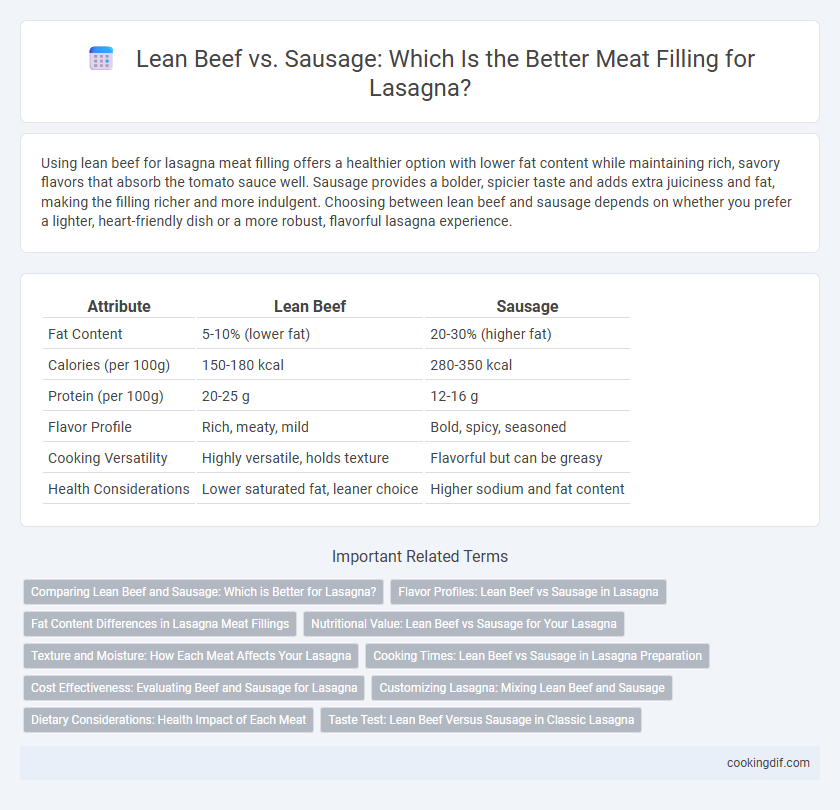Using lean beef for lasagna meat filling offers a healthier option with lower fat content while maintaining rich, savory flavors that absorb the tomato sauce well. Sausage provides a bolder, spicier taste and adds extra juiciness and fat, making the filling richer and more indulgent. Choosing between lean beef and sausage depends on whether you prefer a lighter, heart-friendly dish or a more robust, flavorful lasagna experience.
Table of Comparison
| Attribute | Lean Beef | Sausage |
|---|---|---|
| Fat Content | 5-10% (lower fat) | 20-30% (higher fat) |
| Calories (per 100g) | 150-180 kcal | 280-350 kcal |
| Protein (per 100g) | 20-25 g | 12-16 g |
| Flavor Profile | Rich, meaty, mild | Bold, spicy, seasoned |
| Cooking Versatility | Highly versatile, holds texture | Flavorful but can be greasy |
| Health Considerations | Lower saturated fat, leaner choice | Higher sodium and fat content |
Comparing Lean Beef and Sausage: Which is Better for Lasagna?
Lean beef offers a rich, hearty flavor with lower fat content, making it a healthier choice for lasagna fillings while maintaining a tender texture. Sausage provides a spicier, more robust taste due to its seasoning blend and higher fat, which adds moisture and richness but can result in a greasier dish. Choosing between lean beef and sausage depends on whether you prefer a classic meaty flavor with less fat or a bolder, more flavorful filling that enhances the overall complexity of your lasagna.
Flavor Profiles: Lean Beef vs Sausage in Lasagna
Lean beef offers a mild, savory flavor with a rich, meaty taste that balances well with tomato sauce and herbs in lasagna. Sausage, often seasoned with fennel, garlic, and spices, provides a robust, spicy kick that intensifies the overall flavor profile. Choosing between lean beef and sausage depends on whether you prefer a subtle, classic taste or a bold, seasoned meat filling.
Fat Content Differences in Lasagna Meat Fillings
Lean beef contains approximately 10% fat, resulting in a lower fat content and a leaner texture in lasagna meat fillings compared to sausage. Italian sausage typically has a fat content ranging from 20% to 30%, which contributes to a richer, juicier filling but increases overall calorie and fat levels. Choosing lean beef reduces saturated fat intake, making the lasagna a healthier option while sausage enhances flavor and moisture due to its higher fat content.
Nutritional Value: Lean Beef vs Sausage for Your Lasagna
Lean beef offers a higher protein content with lower saturated fat compared to sausage, making it a healthier option for lasagna meat filling. Sausage typically contains more calories and sodium due to added spices and fats, which can impact heart health. Choosing lean beef can enhance the nutritional profile of lasagna while maintaining savory flavor and texture.
Texture and Moisture: How Each Meat Affects Your Lasagna
Lean beef provides a firmer texture and lower fat content, resulting in a drier, more structured lasagna filling. Sausage introduces higher fat levels and spices, contributing to a juicier, richer, and more aromatic meat layer. The choice between lean beef and sausage significantly affects the moisture balance and mouthfeel of the final lasagna dish.
Cooking Times: Lean Beef vs Sausage in Lasagna Preparation
Lean beef requires a longer cooking time to ensure thorough browning and proper flavor development, typically around 8 to 10 minutes over medium heat. Sausage, especially pre-seasoned varieties, cooks faster, usually in 5 to 7 minutes, releasing its fat and spices more quickly during lasagna preparation. Adjusting cooking times based on the meat type enhances texture and taste, preventing undercooked or overly greasy fillings.
Cost Effectiveness: Evaluating Beef and Sausage for Lasagna
Lean beef offers a cost-effective option for lasagna meat filling, often priced lower per pound compared to Italian sausage. Sausage provides richer flavor but typically comes at a higher cost due to added spices and fats, increasing overall recipe expenses. Choosing lean beef can reduce grocery bills while maintaining protein content, making it ideal for budget-conscious meals.
Customizing Lasagna: Mixing Lean Beef and Sausage
Combining lean beef and sausage in lasagna meat filling balances rich flavors with reduced fat content, enhancing both taste and texture. Lean beef provides a hearty, protein-packed base while sausage adds a savory, spiced depth that elevates the dish's complexity. Customizing the ratio allows for personalized fat levels and seasoning intensity, offering a tailored culinary experience.
Dietary Considerations: Health Impact of Each Meat
Lean beef offers a lower fat content and fewer calories compared to sausage, making it a healthier option for those monitoring cholesterol and calorie intake in lasagna meat fillings. Sausage typically contains higher saturated fats and sodium levels, which can increase heart disease risk and negatively impact blood pressure. Choosing lean beef supports better cardiovascular health and aids in maintaining a balanced diet, especially in Mediterranean or low-fat meal plans.
Taste Test: Lean Beef Versus Sausage in Classic Lasagna
Lean beef offers a mild, savory flavor that allows tomato sauce and herbs to shine, making it a popular choice for a balanced lasagna filling. Sausage delivers a richer, spicier profile with hints of fennel and garlic, enhancing the overall depth and complexity of the dish. Taste tests reveal that combining lean beef and sausage creates a layered meat filling, blending subtlety and boldness for an elevated classic lasagna experience.
lean beef vs sausage for meat filling Infographic

 cookingdif.com
cookingdif.com